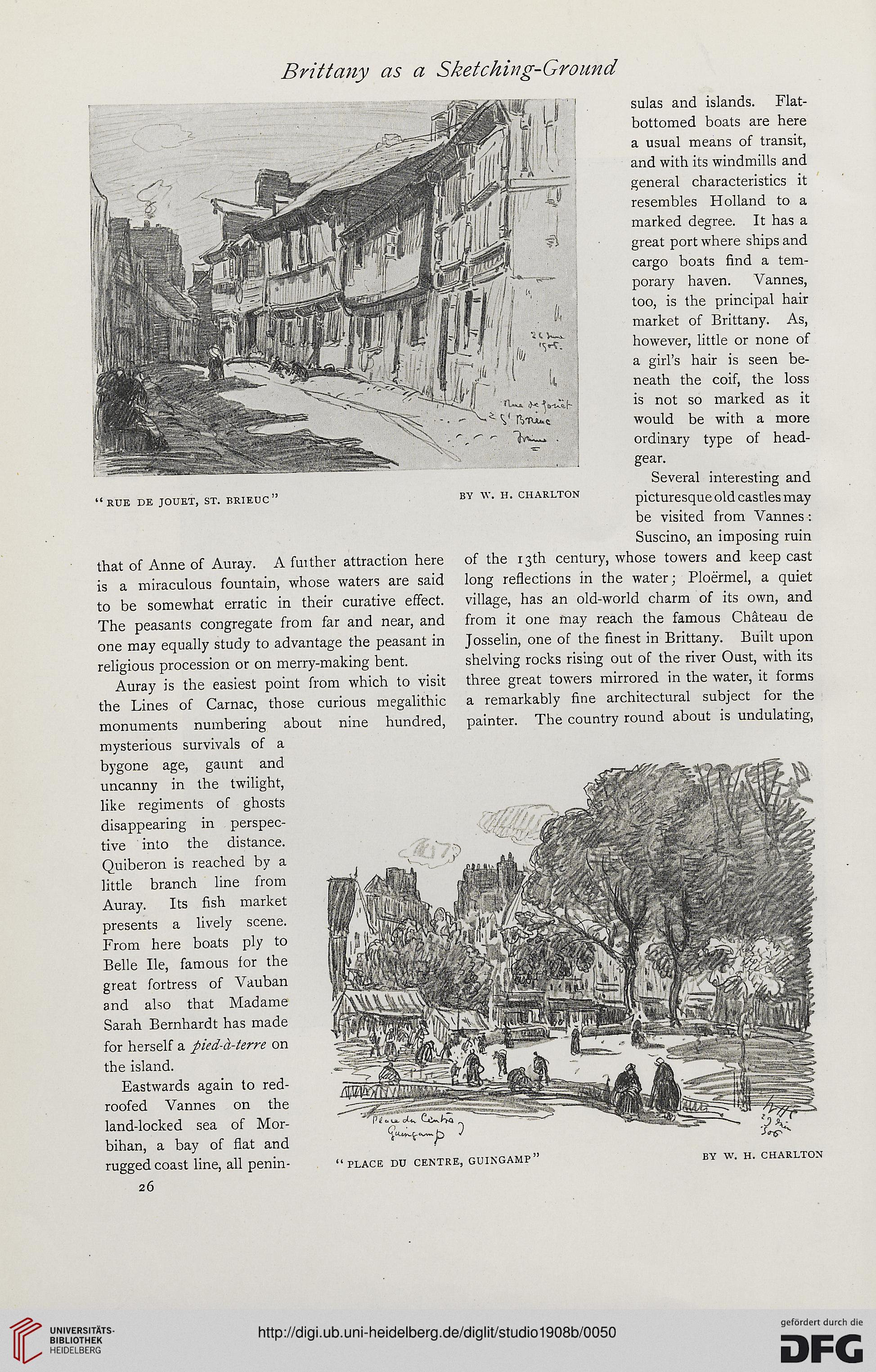Brittany as a Sketching-Ground
'TPlI
Mr.
r a
Vi
■ -H'-
“RUE DE JOUET, ST. BRIEUC”
BY W. H. CHARLTON
that of Anne of Auray. A fuither attraction here
is a miraculous fountain, whose waters are said
to be somewhat erratic in their curative effect.
The peasants congregate from far and near, and
one may equally study to advantage the peasant in
religious procession or on merry-making bent.
Auray is the easiest point from which to visit
the Lines of Carnac, those curious megalithic
monuments numbering about nine hundred,
mysterious survivals of a
bygone age, gaunt and
uncanny in the twilight,
like regiments of ghosts
disappearing in perspec-
tive into the distance.
Quiberon is reached by a
little branch line from
Auray. Its fish market
presents a lively scene.
From here boats ply to
Belle He, famous for the
great fortress of Vauban
and also that Madame
Sarah Bernhardt has made
for herself a pied-d-terre on
the island.
Eastwards again to red-
roofed Vannes on the
land-locked sea of Mor-
bihan, a bay of flat and
rugged coast line, all penin-
26
sulas and islands. Flat-
bottomed boats are here
a usual means of transit,
and with its windmills and
general characteristics it
resembles Holland to a
marked degree. It has a
great port where ships and
cargo boats find a tem-
porary haven. Vannes,
too, is the principal hair
market of Brittany. As,
however, little or none of
a girl’s hair is seen be-
neath the coif, the loss
is not so marked as it
would be with a more
ordinary type of head-
gear.
Several interesting and
picturesque old castles may
be visited from Vannes:
Suscino, an imposing ruin
of the T3th century, whose towers and keep cast
long reflections in the water; Ploermel, a quiet
village, has an old-world charm of its own, and
from it one may reach the famous Chateau de
Josselin, one of the finest in Brittany. Built upon
shelving rocks rising out of the river Oust, with its
three great towers mirrored in the water, it forms
a remarkably fine architectural subject for the
painter. The country round about is undulating,
“ PLACE DU CENTRE, GUINGAMP
BY W. H. CHARLTON
'TPlI
Mr.
r a
Vi
■ -H'-
“RUE DE JOUET, ST. BRIEUC”
BY W. H. CHARLTON
that of Anne of Auray. A fuither attraction here
is a miraculous fountain, whose waters are said
to be somewhat erratic in their curative effect.
The peasants congregate from far and near, and
one may equally study to advantage the peasant in
religious procession or on merry-making bent.
Auray is the easiest point from which to visit
the Lines of Carnac, those curious megalithic
monuments numbering about nine hundred,
mysterious survivals of a
bygone age, gaunt and
uncanny in the twilight,
like regiments of ghosts
disappearing in perspec-
tive into the distance.
Quiberon is reached by a
little branch line from
Auray. Its fish market
presents a lively scene.
From here boats ply to
Belle He, famous for the
great fortress of Vauban
and also that Madame
Sarah Bernhardt has made
for herself a pied-d-terre on
the island.
Eastwards again to red-
roofed Vannes on the
land-locked sea of Mor-
bihan, a bay of flat and
rugged coast line, all penin-
26
sulas and islands. Flat-
bottomed boats are here
a usual means of transit,
and with its windmills and
general characteristics it
resembles Holland to a
marked degree. It has a
great port where ships and
cargo boats find a tem-
porary haven. Vannes,
too, is the principal hair
market of Brittany. As,
however, little or none of
a girl’s hair is seen be-
neath the coif, the loss
is not so marked as it
would be with a more
ordinary type of head-
gear.
Several interesting and
picturesque old castles may
be visited from Vannes:
Suscino, an imposing ruin
of the T3th century, whose towers and keep cast
long reflections in the water; Ploermel, a quiet
village, has an old-world charm of its own, and
from it one may reach the famous Chateau de
Josselin, one of the finest in Brittany. Built upon
shelving rocks rising out of the river Oust, with its
three great towers mirrored in the water, it forms
a remarkably fine architectural subject for the
painter. The country round about is undulating,
“ PLACE DU CENTRE, GUINGAMP
BY W. H. CHARLTON




